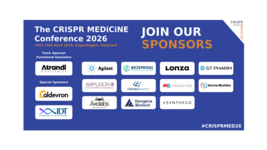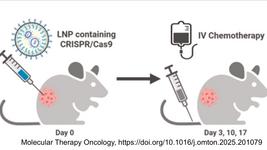CMN Weekly (13 June 2025) - Your Weekly CRISPR Medicine News
By: Gorm Palmgren - Jun. 13, 2025
Top picks
- Researchers at the University of Stuttgart in Germany have developed CRISPRgenee, a dual-action gene-editing system that combines CRISPR-Cas9 knockout with epigenetic silencing using truncated guide RNAs to improve loss-of-function studies. The approach uses ZIM3-Cas9 with both 20-nucleotide and 15-nucleotide guide RNAs to simultaneously cleave target genes and repress transcription, significantly improving gene depletion efficiency whilst reducing sgRNA performance variance compared to conventional CRISPR approaches.
- Vertex Pharmaceuticals has presented extended follow-up data for CASGEVY, their CRISPR-Cas9 gene therapy, showing sustained clinical benefits in sickle cell disease and beta-thalassemia patients after more than 5.5 and 6 years, respectively. In the clinical trials, 95.6% of sickle cell patients remained free from vaso-occlusive crises for at least 12 months, while 98.2% of thalassemia patients achieved transfusion independence. Allelic editing and fetal haemoglobin levels remained stable, and most patients discontinued iron chelation.
Research
- A new programmable RNA acetylation system involves fusing dCas13 with an engineered hyperactive NAT10 variant (eNAT10), enabling precise installation of N4-acetylcytidine (ac4C) modifications on target RNAs. The system revealed that RNA acetylation enhances translation and importantly regulates transcript subcellular localisation, with acetylated transcripts showing cytoplasmic enrichment and nuclear depletion, providing a valuable tool for studying ac4C biology and demonstrating its potential for therapeutic RNA modification applications.
- A new computational framework called CCLMoff uses deep learning and RNA language models to predict off-target effects in CRISPR-Cas9 genome editing with improved accuracy across diverse datasets. The tool addresses a critical limitation in current prediction methods that perform poorly on previously unseen guide RNA sequences.
- CRISPR-Cas9 gene knockout studies in axolotl revealed that the homeodomain transcription factor Shox is essential for proximodistal limb patterning during regeneration. Researchers found that CYP26B1-mediated retinoic acid degradation establishes positional identity along the regenerating limb axis, with Shox specifically required for endochondral ossification of proximal skeletal elements but not autopod formation.
- Japanese researchers have developed a high-throughput robotic method for isolating and analysing genome-edited human induced pluripotent stem (iPS) cell clones, overcoming the challenge of single-cell survival in these fragile cells. Analysis of over 1,000 clones revealed that CRISPR-Cas9 editing in human iPS cells predominantly produces homozygous rather than heterozygous modifications, with frequent identical insertions and deletions occurring in both alleles of target genes. This previously unknown property has important implications for therapeutic genome editing applications.
- Enhanced CRISPR interference (CRISPRi) systems have been developed by screening over 100 novel repressor domain fusions combined with potent KRAB repressors to overcome limitations of incomplete knockdown and performance variability. They identified a particularly effective platform, dCas9-ZIM3(KRAB)-MeCP2(t), which demonstrated improved gene repression with reduced dependence on guide RNA sequences and enhanced functionality across multiple cell lines and genome-wide screens, offering greater reproducibility for mammalian CRISPRi applications.
- Positively charged injectable hydrogels have been demonstrated to enable efficient intratumoral co-delivery of CRISPR-Cas9 ribonucleoproteins targeting YB-1 and doxorubicin, enhancing cellular uptake, gene editing, and anti-tumour efficacy in melanoma models. Compared to neutral or negatively charged hydrogels, the system showed prolonged tumour retention, improved drug synergy, and reduced systemic toxicity, addressing key delivery and safety challenges in CRISPR-Cas9-based cancer therapy.
- A novel platform harnesses transcription factors (TFs) to dynamically regulate CRISPR-Cas12a trans-cleavage activity through engineered DNA translators that change conformation upon TF binding. Using TATA-binding protein and Myc-Max as models, the system demonstrated precise, tunable control with rapid kinetics. It enabled the creation of synthetic biology networks, including fluorogenic RNA aptamer activation and multimolecular communication pathways between Cas12a and Cas13a, establishing TFs as effective CRISPR regulators for novel protein-nucleic acid communication applications.
Industry
- Modalis Therapeutics has partnered with SOLVE FSHD to advance the development of an experimental epigenome-editing therapy for facioscapulohumeral muscular dystrophy. The collaboration will fund Modalis' MDL-103 programme, which is designed to silence the expression of the disease-causing DUX4 gene.
- The US Court of Appeals upheld a ruling invalidating Agilent's patents on chemically modified guide RNAs used in CRISPR-Cas9 gene editing following Synthego's successful challenge. This decision removes patent barriers around 2'-O-methyl modified guide RNAs and guide RNAs with specific 5' and 3' end modifications, potentially enabling broader innovation in CRISPR therapeutics development.
- MaxCyte and Ori Biotech have partnered to integrate their ExPERT™ electroporation and IRO® manufacturing platforms to enhance gene-edited T-cell production. The collaboration will test CRISPR-Cas knock-in of CD19 CAR expression in activated T cells, aiming to improve yields and reduce manufacturing timelines compared to traditional post-electroporation expansion methods.
Clinical and preclinical
- SNIPR Biome has dosed the first patient in its Phase 1b trial of SNIPR001, a CRISPR-CAS-armed bacteriophage therapy that represents a new frontier in precision antimicrobial treatment. The randomised, double-blind, placebo-controlled study will evaluate this innovative approach in 24 haematological cancer patients undergoing stem cell transplantation across eight US centres.
- Fate Therapeutics has reported that all five patients with severe lupus treated with FT819, their off-the-shelf CRISPR-edited, iPSC-derived CAR-T therapy targeting CD19, achieved significant disease improvement with reduced or no conditioning chemotherapy. Notably, one patient maintained drug-free remission at 12 months, whilst another achieved disease control when FT819 was added to maintenance therapy without any conditioning regimen. The CRISPR-editing enables both the CAR insertion and the safety/compatibility profile required for allogeneic use.
- Editas Medicine achieved 58% on-target editing of HBG1/2 promoters in hematopoietic stem cells using their AsCas12a-based gene editing system delivered in vivo via targeted lipid nanoparticles in non-human primates. The preclinical study exceeded the 25% editing threshold predicted for therapeutic benefit in treating sickle cell disease and beta thalassaemia whilst demonstrating reduced liver uptake compared to standard nanoparticles.
- Beam Therapeutics’ BEAM-101base-editing therapy for sickle cell disease showed strong safety and efficacy in 17 patients from the Phase 1/2 BEACON trial. Patients achieved >60% HbF, <40% HbS, rapid engraftment, and no VOCs post-treatment. The therapy improved red blood cell function and hemolysis markers, with durable responses up to 15 months, supporting its potential as a one-time, transformative treatment.
Perspectives and commentaries
- UCLA researchers provided a comprehensive perspective on using induced pluripotent stem cells (iPSCs) as a scalable platform for next-generation allogeneic CAR cell therapies. They highlighted how iPSCs address key limitations of traditional donor-derived cells through unlimited expansion capacity, precise genetic editing using CRISPR-Cas9, and the ability to generate standardised cell products whilst avoiding ethical concerns associated with embryonic stem cells.
- A new study analysed German media coverage of New Genetic Technologies (NGTs), particularly CRISPR-Cas9, from 2012 to 2023 across four major newspapers using topic modelling and frame analysis. The research revealed a notable shift toward a more favourable media portrayal of NGTs compared to historically critical coverage of traditional genetic technologies. More positive frames like "progress" and "agricultural productivity" predominate over critical frames, particularly regarding agricultural applications, suggesting media influence on public attitudes and regulatory outcomes for genetic technologies.
Reviews
- Charting the development and engineering of CRISPR base editors: lessons and inspirations. This review summarises recent advances in the development and engineering of CRISPR base editors, including diverse types such as CBEs, ABEs, transversion and dual editors, with a focus on technical innovations, workflows, and ongoing challenges.
- Targeting RNA Adenosine Editing and Modification Enzymes for RNA therapeutics. This review examines the therapeutic potential of targeting RNA modifications – specifically A-to-I editing by ADARs and m6A methylation – highlighting preclinical evidence for their roles in disease and the efficacy of small molecule inhibitors and RNA-guided editing strategies.
- The Use of CRISPR-Cas Systems for Viral Detection: A Bibliometric Analysis and Systematic Review. This review analyses global trends in CRISPR-Cas research for viral detection (2019–2024), highlighting rapid growth led by the US. CRISPR-based diagnostics offer faster, more precise, and accessible alternatives to traditional methods, particularly suited for point-of-care use in resource-limited settings, underscoring their transformative potential in equitable viral diagnostics.
- Epigenetic reprogramming in breast cancer: The role of CRISPR-Cas 9. This review explores CRISPR-Cas9-based epigenetic editing for breast cancer therapy, highlighting its potential to reactivate silenced tumour suppressors and suppress oncogenes via targeted DNA methylation and histone modification. It underscores the promise of combining CRISPR tools with existing treatments to enhance efficacy and overcome resistance, paving the way for personalised, durable breast cancer therapeutics.
Detection
- Researchers in China have developed a dual-color fluorescence fiber-embedded optofluidic nano-biochip (CD-FOB) using orthogonal CRISPR/Cas systems for rapid parallel detection of bacterial and viral co-infections. The platform achieved ultrasensitive detection of E. coli O157:H7 (643 CFU/mL) and SARS-CoV-2 (3.48 copies/μL) within 50 minutes without amplification, using multiple signal enhancement strategies, including CRISPR collateral cleavage and evanescent wave fluorescence, with lyophilised reagents enabling practical on-site pathogen detection for clinical applications.
To get more CRISPR Medicine News delivered to your inbox, sign up to the free weekly CMN Newsletter here.
Tags
ArticleMissing linksNewsCMN WeeklyEditas Medicine, Inc.Fate Therapeutics, Inc.Modalis TherapeuticsSNIPR BiomeVertex Pharmaceuticals, Inc.
CLINICAL TRIALS
IND Enabling
Phase I
Phase II
Phase III
Gastric Cancer and Colorectal Cancer, CRC, (NCT07166263)
Sponsors:
Base Therapeutics (Shanghai) Co., Ltd.
Sponsors:
Base Therapeutics (Shanghai) Co., Ltd.
IND Enabling
Phase I
Phase II
Phase III
Relapsed or Refractory Acute Myeloid Leukemia, AML, (NCT06541444)
Sponsors:
Base Therapeutics (Shanghai) Co., Ltd.
Sponsors:
Base Therapeutics (Shanghai) Co., Ltd.
IND Enabling
Phase I
Phase II
Phase III







